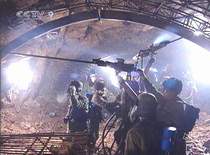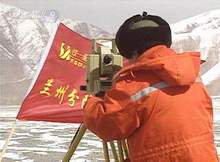|
Qinghai-Tibet Railway 
|
| 2002-10-15 10:46:58 |
The Qinghai-Tibet Railway is the most important project in China's Western Development program. China decided to start building the railway because it is now capable of solving some of the problems in railway construction on the highest plateau in World.
 On the Qinghai-Tibet Plateau, the Roof of the World, an army of 250,000 construction workers is working against the clock and the harshest conditions. They are building the world's longest and highest railway here -- the Qinghai-Tibet railway.
On the Qinghai-Tibet Plateau, the Roof of the World, an army of 250,000 construction workers is working against the clock and the harshest conditions. They are building the world's longest and highest railway here -- the Qinghai-Tibet railway.
With a total investment of 26.2 billion yuan, the construction of the railway is the number one project in China's Western Development program, aimed at boosting the development of the vast and underdeveloped western areas.
Linking Xining, capital of Qinghai province, with Lhasa, capital of the Tibet Autonomous Region, the total length of the Qinghai-Tibet railway is nearly 2,000 kilometers. In 1984, the section from Xining to Golmud which runs through the Qaidam Basin was finished and put into operation. But the construction of the railway stopped short of its total length.
"This is the starting point of the newly-built section of the Qinghai-Tibet railway. In the 1980s, the laying of the tracks stopped right here, just before they entered the high mountains. The construction didn't continue because engineers then couldn't solve some of the tricky problems."
 There are three main problems confronting the builders of the railway. Number one, the high altitude and lack of oxygen, which pose a big threat to the health of the workers. Number two, the permanently frozen ground, which makes the foundation of the tracks vulnerable to sinking and loosening. And number three, environmental protection -- how to limit the damage to the fragile vegetation and wildlife on the Qinghai-Tibet plateau.
There are three main problems confronting the builders of the railway. Number one, the high altitude and lack of oxygen, which pose a big threat to the health of the workers. Number two, the permanently frozen ground, which makes the foundation of the tracks vulnerable to sinking and loosening. And number three, environmental protection -- how to limit the damage to the fragile vegetation and wildlife on the Qinghai-Tibet plateau.
These and other problems have made the construction of the railway the most difficult endeavor in the history of railway construction. The following figures might give you some clue of the difficulties of the project.
The total length of the railway under construction is 1,110 kilometers.
960 kilometers will be over 4,000 meters high.
The highest point of the railway will be 5,072 meters above sea level.
550 kilometers will cross a permanently frozen region.
According to Lu Chunfang, General Manager of the Qinghai-Tibet Railway Company which is in charge of all construction, the Chinese government decided to start the project last year because the country is more capable both financially and technically now than 20 years ago.
 Lu Chunfang, General Manager of Qinghai-Tibet Railway Company said:"After 20 years of opening and reform, China has seen marked development in both its financial strength and technological level. I should say that the timing is right for the Chinese government to make the decision to start the project at the beginning of the new century."
Lu Chunfang, General Manager of Qinghai-Tibet Railway Company said:"After 20 years of opening and reform, China has seen marked development in both its financial strength and technological level. I should say that the timing is right for the Chinese government to make the decision to start the project at the beginning of the new century."
Indeed, the Chinese have basically solved these three main problems. Since the project started on June 29, 2001, not a single death caused by high altitude sickness has occurred among the thousands of construction workers.
Chinese scientists have also developed many techniques to deal with the permanently frozen ground, such as using a thermal insulating layer, controlling the thickness of the track foundation and using bridges instead of laying tracks directly on the earth's surface.
As for environmental protection, the issue was given top priority both in the design and during construction.
 He also said: " First in the design of the railway, we have taken a lot of measures to protect the environment, such as limiting the areas to get sand and stones, reducing the discharge of waste water to the largest extent possible and collectively treating garbage. 1.2 million yuan was set aside for environmental protection."
He also said: " First in the design of the railway, we have taken a lot of measures to protect the environment, such as limiting the areas to get sand and stones, reducing the discharge of waste water to the largest extent possible and collectively treating garbage. 1.2 million yuan was set aside for environmental protection."
Measures are also taken to protect wildlife peculiar to the plateau, many species of which are on the endangered list. To protect their migration patterns, passages have been built at their migration routes.
All the construction companies involved have signed a responsibility contract with local environmental protection departments. And a third party is ensuring that all measures are strictly followed.
The builders hope that after the completion of the railway, they will not only bring economic prosperity to the region, but also leave the environmental purity of the mostly untouched, and starkly beautiful plateau.
|
|










